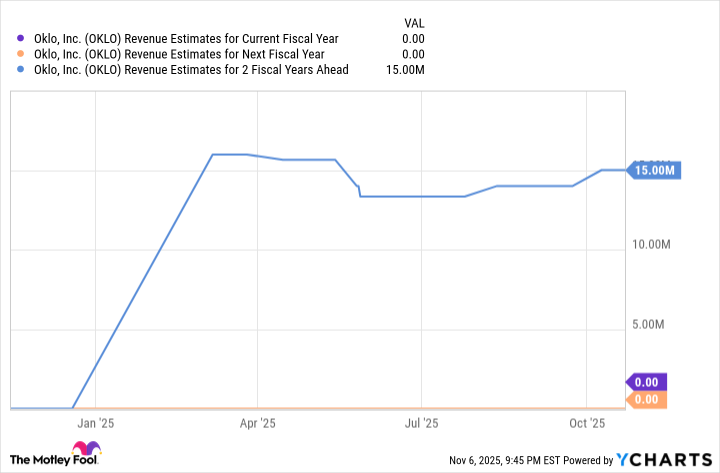Picture, for a moment, the classic image of a nuclear power plant. The hourglass cooling tower, a plume of steam rising from the top, maybe some industrial equipment around it.
Now strip the cooling tower from your mental image. And let's replace it with something else, something a little more pleasing on the eye: an eco-cabin in the woods, with a sharp roofline like a Nordic cathedral.
That, in a nutshell, is the kind of reactor the nuclear start-up Oklo (OKLO 2.63%) is trying to build.

A rendering of an Oklo "Aurora" powerhouse. Image source: Oklo.
Clearly, Oklo's reactor isn't isn't the kind you'd see in The China Syndrome or Chernobyl. Indeed, you wouldn't even see Oklo's in the wild: its "Aurora" powerhouse only exists as a rendering. The company is still in the early stages of development -- it doesn't have regulatory approval to operate Aurora commercially -- and yet its stock has shot up triple-digits on the year.
What's behind Oklo's magic? And can this nuclear stock still grow from here?
A reactor fit for the era of AI
Oklo is designing a small, fast-spectrum nuclear reactor with complementary fuel recycling capabilities. Its vision is to revolutionize nuclear power by building small, modular reactors and sell clean power under long-term contracts.
Its largest opportunity is -- you guessed it -- with artificial intelligence (AI). It's not hard to imagine why. Oklo's powerhouse is small enough that it could be housed within a hyperscale data center without intrusion. And since these reactors run continuously, they can provide reliable 24/7 power to thirsty AI models.

NYSE: OKLO
Key Data Points
Oklo's model could be appealing to other companies as well. Mining companies, for instance, could use them to power remote sites where grid access is limited or diesel too costly. The same could apply to military camps, research bases (think: Antarctica), disaster-relief zones, and other industrial facilities.
Fast-tracking the regulation process
As noted earlier, Oklo isn't licensed to operate just yet, but it's getting closer.
After its first application was denied in 2022, the company has reconnected with the Nuclear Regulatory Commission (NRC). In July 2025, it cleared phase 1 of the pre-application readiness review. Up next is a formal application, another acceptance review, and a full technical evaluation that spans design, safety, and environmental factors.
This process normally takes several years. However, thanks to recent leglislative moves the Trump administration made relted to nuclear power, Oklo's countdown to deployment could move a little quicker.
In May 2025, the White House issued an executive order -- "Reforming Nuclear Reactor Testing at the Department of Energy" -- aimed at overhauling how the Department of Energy (DOE) tests and approves advanced nuclear reactors. In a nutshell, it asks the DOE to accelerate reactor testing at national labs, with the explicit aim of approving three advanced reactor design by mid-2026.
Oklo is among a handful of companies whose reactor design has been fast-tracked for deployment through this initiative. Indeed, in September 2025, Oklo broke ground on its first Aurora powerhouse at Idaho National Laboratory (INL). If all goes well -- and there's still a lot to demonstrate -- the company could turn on its first commercial reactor in 2027.
Should you buy Oklo stock while it's below $120?
At today's price, Oklo is trading about 40% lower than its mid-October highs (around $170 a share). Given the policy winds at its back, it could have plenty of lift long-term. At the same time, there are risks -- and its valuation is one of them.
Despite having zero revenue and no reactor in operation, Oklo's market cap sits around $16 billion at today's price. That's extraordinary for a start-up that's still in the research and development (R&D) phase.
For comparison, NuScale Power (SMR 4.18%) -- another advanced nuclear company designing a small reactor -- is valued at around $8.5 billion. And that's a company with an approved reactor design and revenue (well, some).
Investors will likely have to wait a year or two before Oklo is seeing significant top-line growth. Indeed, one estimate projects a meager $15 million in total revenue for 2027.
OKLO Revenue Estimates for Current Fiscal Year data by YCharts
Then there are capital costs. Securing fuel, building production facilities, funding NRC compliance, and training a workforce will likely pressure the company's balance sheet long before it's profitable.
Add in other potential headwinds -- like a party change in the White House or an engineering problem in its design -- and this growth stock could get bumpy in the near term.
As such, Oklo is a speculative play on the future of energy, but not a core position. Even with shares below $120, this stock is for risk-tolerant investors only. More conservative investors may want to sit this one out, or track the nuclear energy market with an exchange-traded fund (ETF).
